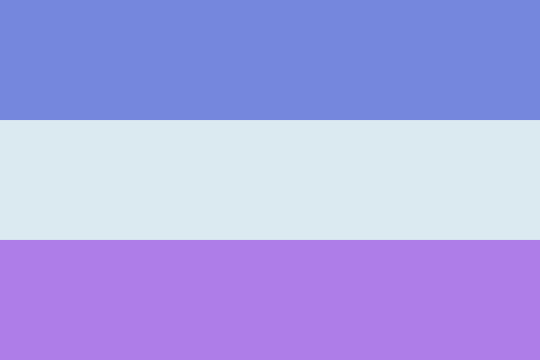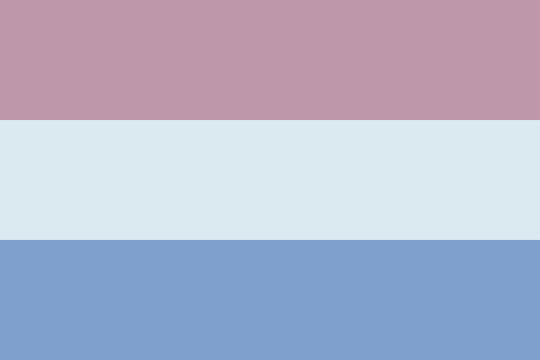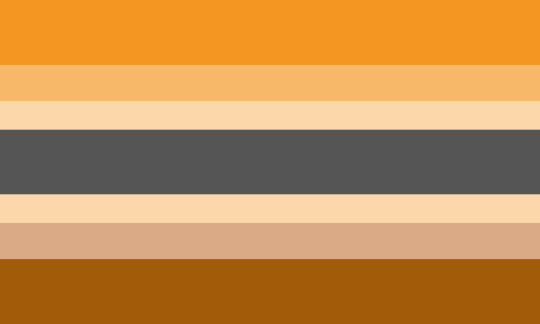#ilyagine presenting
Explore tagged Tumblr posts
Text
Gender-quality presenting flags :D
Wanted to make some presentation flags that were missing (or at least, I don't know of any flags for these terms), so here they are. (May or may not be part of a bigger flag project)




abine presenting ✦ midbine presenting ✦ bine presenting [pt: abine presenting, midbine presenting, bine presenting.]
✦ abine also can be called abinarine & abinine. ✦ midbine also can be called midbinarine & midbinine. ✦ bine also can be called binarine.




atrine presenting ✦ midtrine presenting ✦ trine presenting [pt: atrine presenting, midtrine presenting, trine presenting.]
✦ atrine also can be called atrinarine & atrinine. ✦ midtrine also can be called midtrinarine & midtrinine. ✦ trine also can be called trinarine.




ilyagine presenting ✦ aporine presenting ✦ outher presenting [pt: ilyagine presenting, aporine presenting, outher presenting.]
✦ aporine can also be called aporaine. ✦ outher can also be called outhr, outhrine, & outherine.


keno presenting [pt: keno presenting.]
✦ keno can also be called kenoine & kenous.

↓ References: ✦ original gender-quality-presenting flag format (feminine, masculine, neutral, & xenine presenting). ✦ nonbine, androgynous, genderless, & maverine presenting flags (in the same format). ✦ nonbine, midbine, abine, & atrine (alt) flags. ✦ binarine flag. ✦ midtrinarine flag. ✦ trinarine flag. ✦ ilyagine flag. ✦ aporine flag. ✦ outherine flag. ✦ kenoine flag.

So they all follow the above gender-quality presenting flag format (3 stripes, with the outer 2 stripes being for the gender-quality in question).
I just took the colours of the above gender quality flags, simplified them to 2 colours, and used them on the edges. Pretty straightforward. The only slight exception is atrine presenting, which has a lightly yellower center grey stripe. This is to help a bit with contrast, and match the general aesthetic I do with atrinary flags (where atrinary yellowish white is used instead of plain white, or whatever the default light center colour of the flag format is).
#gender-quality presenting#abine presenting#midbine presenting#bine presenting#atrine presenting#midtrine presenting#trine presenting#ilyagine presenting#aporine presenting#outher presenting#keno presenting#pride flag#new flag
34 notes
·
View notes
Text
Ilyaginity
Ilyaginity is a term I coined last year to describe the quality of Ilyagender and genders related, similar, derived from it.
(Here the archived version of the coining post I made last year)
Ilyagine genders are all characterised by a tangible sense of gender that's neither feminine/masculine/neutral nor derived, a mix/in between, similar, or in any way related to those three main qualities, while being neither xenine nor a lack of gender/beyond the concept of gender.
The gender nature is ILYIN; and its viagender counterpart is ILYIA.
The Ilyagine flag
[the ilyagine flag]

[ID: The ilyagine flag has six horizontal stripes, each of a different colour. The colours, from top to bottom, are: brown, light tan, dark grey, beige, yellow-ish orange, pastel orange. All the stripes are the same size./END ID]
---
Ilya-alignment: Albireian
[PT: ilya-alignment: albireian]
A term for someone who is ilya-aligned. Having an alignment towards ilyagenderness.
Some ways to be albireian:
Someone who is partially ilyagender.
Someone who has some sort of connection to ilyagenderness, regardless of actual gender.
Someone who has a gender similar to, but not the same as ilyagender.
Someone who is ilyingender/connected to ilyaginity regardless of actual gender.
A non-binary individual who presents ilyaginely, regardless of actual gender.
Someone connected to ilyagenderness through their experience with society. They may be treated as and/or have experiences similar to that of Ilyagender.
The term "albireian" comes from the star Albireo.
The albireian flag:

[ID: A flag with five horizontal stripes, all of different colours. From top to bottom, these are: brown, orange, light yellow. /END ID]
Albireian coining post (archived)
Some Ilyagine genders:
[PT: some ilyagine genders]
Ilyagender: The OG ilya- gender. Coined by Epochyphal in 2014, who defined it as "having a tangible presence of gender, one which is not man, woman, neutral, or agender in any way, nor between or a combination or derivation."

Proxilya: Coined by me (archived here). It's the circabinary equivalent of ilyagender and its definition is: "A gender near ilyagender. It's relative to ilyagender, but separate and entirely on its own. It's proximal to ilyagender in the gender spectrum."

[ID: A flag with four horizontal stripe, from top to bottom: dark brown, dark yellowish-brown, yellowish brown, and pastel tan.All the stripes are the same width./End ID]
Ilyaen: A generic monolexic word that any ilyagender or otherwise ilyagine gendered person can use. The Ilyagine/Ilyagender equivalent to (wer)man/woman. (archived)

[ID: A flag with four horizontal stripes, from top to bottom: brown, light grey-ish brown, light orange, and orange. The two middle stripes are slightly wider than the top and bottom ones. /End ID]
10 notes
·
View notes
Text
Some points about mavraen and Ilyaen.
So, I coined them - in my now deactivated blog outherwordlycoinings - as maverine/maveriquine and ilyagender (because at the time I hadn't coined Ilyagine yet) counterparts to (Wer) man and woman.
Being parallels of those two terms, any usage you can think of for them can be applied to mavraen and ilyaen for their respective genders and qualities.
If and because "man" and "woman" are used both as specific genders, but also as macro-genders that can describe not only any miaspec/fiaspec or gendervir/genderera gender, but also any mingender or fingender (there are people, for example, that call themselves woman because their feminine presentation or alignment is important to their overall gender experience, even if their gender is not female or lierine/eraine at the centre/core. Same with MIN nonmiaspec/nonvir men),
The same usages apply to mavraen regarding mviagenders and mviagenders and to ilyaen regarding ilyiagenders and ilyingenders.
Ilyaen is also a monolexic alternative to ilyagender, for those who prefer shorter terms.
But (and big but), if they're parallels and can be used in a similar fashion to man and woman, then do the "restrictions" of those terms also apply? More specifically, are these terms age specific?
In this case yes. I (being an adult) don't Identify with juvenile terms that are equivalent to girl/boy (and never did actually. As a kid I hated those terms. As an adult I do identify with several -(m)an term, but still hate the juvenile versions, which don't even apply to me any more) I coined these terms because I wanted more adult/mature terms to express my genders. I wanted equivalents of man and woman for some of my gender experiences (or aspects of it), understanding the "basic" definition as "[gender quality/experience] adult person"
So they're "mature" terms, coined with mviagender/mvingender and ilyiagender/ilyingender/ilyagender adults like myself in mind because there's a lack of terms for us, because most "equivalent" terms tend to be juvenile, parallel to boy and girl, as if boy and girl were somehow less binary (thus most worthy of compare your gender to) than man and woman (they're not)
2 notes
·
View notes